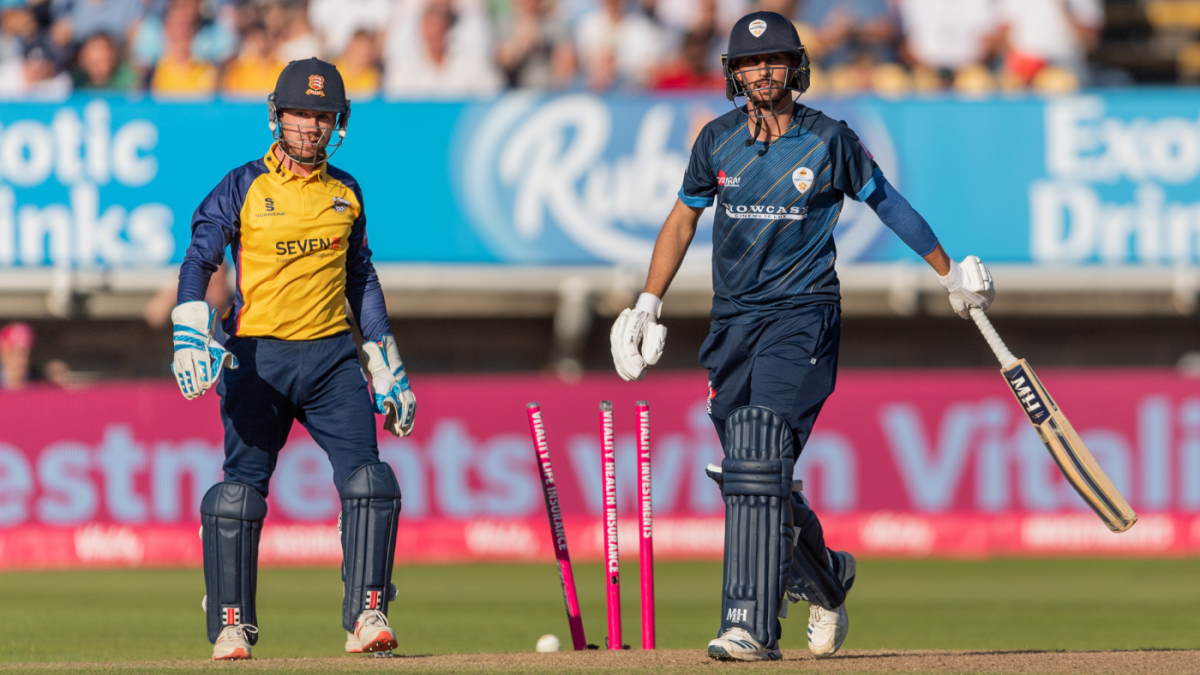Sports are ever-evolving. Leagues constantly compete to be the best in terms of viewership, attendance, and fan involvement. The driver behind this competition is revenue (surprise, surprise) with views and fan engagement the key to financial success.
Recently, the modernization of sports has led to a “hyper-evolution” as leagues try to keep up with rapidly changing consumer habits. Younger fans consistently prefer watching highlights to full games, especially when compared to their older counterparts. For instance, 48% of NFL fans aged 18-34 said they prefer watching highlights instead of complete games. In the age 50+ group, only 11% said they prefer watching highlights over the live games.
The trends are clear: young fans continue to signal a need for faster, modern, highlight-filled games.
One way that a league can get ahead of the rest is through new rules and formats that revitalize the game. All professional sports leagues have a feeder league of some sort, like the NBA’s G-League, through which young talent can try out for the highest stage of competition. When a professional league needs to test a new and potentially game-changing rule, there’s no better place than a feeder league, or a new league altogether.
Outside of established professional leagues, there are constantly new leagues sprouting up that bend the rules of sport and play. Some bend these rules to an extreme, like the now-defunct professional Slamball league, which featured a version of basketball played entirely on trampolines. While it’s unlikely we’ll see Kevin Durant on a trampoline any time soon, there are some leagues that utilize rule changes that could one day be brought to the forefront of the sport.
Twenty20 Cricket, an experimental version of Cricket that arrived in 2003 and allowed the sport to be played in three hours instead of five days, has had a tremendous impact on the sport. This goes further than changing the rules: it was a full cricket reformat that was met with significant resistance when it was first introduced. However, Twenty20’s current success is unmistakable: the top-five earning cricket leagues in the world are all T20.
The first six.
The first music set.
The first champions.The first-ever #TheHundred! 😍 pic.twitter.com/ITPpzd6nwi
— The Hundred (@thehundred) August 26, 2021
As if one variation wasn’t enough, over the last few months another new format was introduced to the cricket world, The Hundred. The men’s and women’s tournament took place in England in July and August, and is an even faster paced game in which each team plays a single hundred-ball innings. The Hundred only takes about two and a half hours per match, which is more comparable to the length of a baseball game. Similar to T20, there is significant resistance from cricket traditionalists about The Hundred’s fast pace, but the results are clear: 55% of people who bought The Hundred tickets had never been to a cricket match before, and the tournament set several television and attendance records.
Many modern sports leagues are trying to make similar moves to what T20 and The Hundred did, working towards a faster, harder-hitting, and more engaging game, in order to ensure fans are satisfied. Here are some of the most innovative new leagues and rules currently being tested to keep sports as engaging and entertaining as possible.
Basketball’s Elam Ending
Basketball is an enjoyable, fast-paced sport with minimal waiting in-between plays and lots of high-intensity action. However, the most important part of the game can often be completely negated by strategy.
Intentional fouls at the end of the game are an integral part of basketball, allowing the losing team to save time in a last-gasp attempt at winning. While intentional fouls are a good strategic play, they can completely ruin the end of the game, forcing fans to watch a litany of free throws instead of a real battle.
A 5-on-5 tournament with a $1 million cash prize called ‘The Basketball Tournament’ aims to change that, with the help of a man named Nick Elam. In 2017, The Basketball Tournament implemented the “Elam Ending,” a new strategic way to end basketball games that involves teams playing to a target score, set with four minutes left in the fourth quarter, instead of playing until the clock runs out. By having teams play to a target score, the game will always end on a made basket.
According to The Basketball Tournament’s website, the addition of the Elam Ending “led to a noticeably better end of game experience both on the court and in the stands.”
Here’s an example of The Basketball Tournament’s Elam Ending at work:
THIS ENDING WAS ABSOLUTELY INCREDIBLE‼️‼️‼️‼️ @OnceABrave USES A 16-7 RUN IN THE ELAM ENDING TO STUN HOOPVILLE 75-73. pic.twitter.com/BJ4HcUZN9r
— TBT (@thetournament) July 25, 2021
The NBA took notice of the Elam Ending in 2020, and the league now utilizes the Elam Ending in their All-Star Game each year, with 24 points tacked on to the leading team’s score going into the fourth quarter in an homage to the late Kobe Bryant. In its first implementation, the change was an immense success, turning the usually lackluster showing of All-Star talent into an intense game that ended up being won by only two points.
Following the game, sports pundit Tony Kornheiser made an argument for the NBA to immediately integrate the Elam Ending. While that hasn’t happened, his argument makes it clear the ending could very easily be integrated in the future.
“I’m going to suggest that the NBA immediately adopt this [@ElamEnding] format for overtime in regular season games…Look at how much people like it!” – Tony Kornheiser on @PTI 👏
— TBT (@thetournament) February 17, 2020
The Atlantic League
A problem facing Major League Baseball can be summed up in one word: timing. The games are simply too long for some fans. In an era of highlight-driven viewership, the MLB has done a good job of creating a more feast-or-famine game that focuses on home runs: four of the last five MLB seasons are in the top five home-run hitting seasons ever.
However, professional baseball still faces stiff competition from other sports. It’s been a struggle for ‘America’s Pastime’ to keep modern fans’ attention, especially the new generations of fans.
In search of an answer to how to modernize its game, the MLB came across a testing ground: the Atlantic League. Founded in 1998, the Atlantic League has operated for 20+ years as an independent baseball league in cities without a major league franchise. In 2019, they entered into a deal with the MLB to become an official partner. The partnership allowed the MLB to implement changes to the Atlantic League’s rules in order to test the effects of future rule-changes. The most major rule change was immediately implemented: a pitch clock, limiting the time between pitches in an attempt to speed up the game.
Last season, the Atlantic League introduced what could become one of the most revolutionary tech-based enhancements to the MLB since its creation: the robot umpire. The Automated Ball-Strike System uses camera tracking to determine whether a pitch is a ball or a strike with AI precision. At the moment, the system is used in tandem with a live umpire. The system’s determination is fed verbally into the home-plate umpire’s earpiece, and then it’s up to that umpire to determine whether the system made the right decision.
In the future, it may no longer be up to the live umpire at all, as the system’s accuracy increases year-over-year. An MLB with automatically determined strikes and balls would definitely improve fan morale – egregiously wrong calls are often the source of major complaints from fans on social media. There’s even an account on Twitter with over 50 thousand followers dedicated to auditing every umpire’s calls during each game.
Yesterday, Umpire Angel Hernandez was responsible for the worst called game of the season so far. He missed 24 calls with a correct call percentage of only 83.2%.
These called strikeouts to @ABREG_1 and @Machete1224 were two of his worst.@Astros v @Angels pic.twitter.com/n194czS0Bk
— Umpire Auditor (@UmpireAuditor) April 7, 2021
Most recently, the league implemented its newest experiment. The pitching mound was moved back one foot, to a new distance of 61 feet and 6 inches, in an effort to make batting easier to add more action and points to games. While a single foot seems like a minor change, the effect of the change has become noticeable – but not in the way one would expect. While statistically the game has remained nearly the same (the strikeout rate surprisingly actually increased by 0.5%), the effect on the players’ morale and health has been more drastic. According to CBS Sports’ R.J. Anderson, the league’s players almost went on strike as a result of the change. Pitchers complained about health and soreness, while batters complained about the change in timing. The players felt that despite being professionals in their sport, they were being treated like guinea pigs. It goes to show that behind every sports experiment are real people – and if the experiment fails, those people may have something to say about it!
Fan Controlled Football
The National Football League isn’t just the most profitable professional sports league in the United States – it’s the most profitable league in the world. The NFL’s overwhelmingly large brand and fan base has made it the only sustainable professional football league in America. The most recent attempts at alternative football leagues, the XFL and AAF, both only lasted a single season. This makes sense, other than playing their seasons in Spring instead of fall the leagues didn’t offer anything different than the NFL, and had nothing near the NFL’s star power.
In 2017, a group of entrepreneurs, former and current NFL players, and other athletes and influencers from nearly every faction of the sports industry came together to try to create a brand new football league. Originally dubbed the “Interactive Football League,” the Fan Controlled Football League was founded on a simple premise: the fans decide everything. Everything as in everything. From league rules, to team branding (including logos and uniforms), to which players the team signs/drafts, the league is built to be a completely interactive fan experience. The teams are owned by likeable celebrities: Marshawn Lynch, Quavo, and Richard Sherman, to name a few.
The league’s fan-voted rules are wacky and enjoyable, putting a new spin on an American classic. From the opening, the league emphasizes friendly competition, beginning with a game of rock-paper-scissors instead of the NFL’s coin toss to determine who receives the kickoff. Each team plays with seven players on the field instead of eleven, including a three-man offensive line. Teams have the opportunity to retain possession following a score with a one-shot play – if they gain 10 yards, they retain possession. There’s no kicking or punting, only one timeout per team, and many other minor changes.
During games, fans vote on their team’s next play in real-time. In addition, fans decide the outcome of replay reviews of close calls. While the FCF lacks the star-power of the NFL, the ability to have an impact on every game kept fans engaged through the league’s inaugural season, which ended in March.
What’s Next
Sports are moving towards a more streamlined, fan-based approach. In the age of social media, leagues are under constant pressure to keep fans happy or face the consequences of group mentality. Innovation is important in order to keep sports fresh for fans, and keep them profitable for the leagues. Who knows what the future holds for professional sports, but one thing that can certainly be expected is for all sports to strive to become more and more exciting in the coming years as they battle each other (and the many other modern day distractions) for fan engagement supremacy.
Image Credit: Nigel Parker / Shutterstock.com



